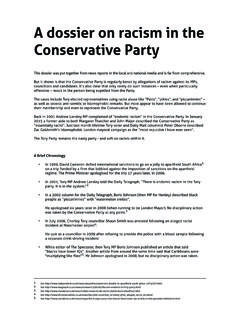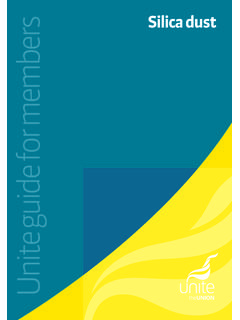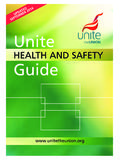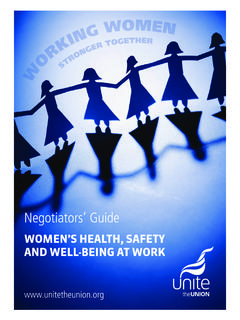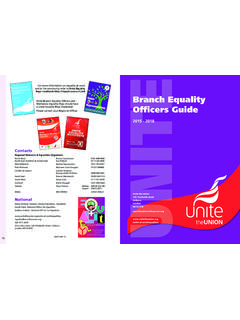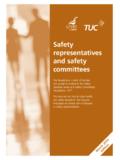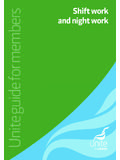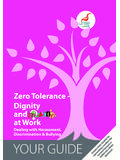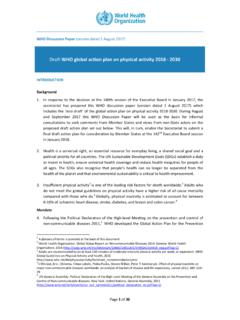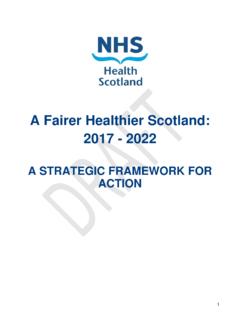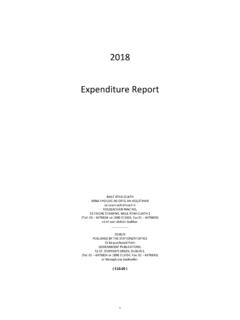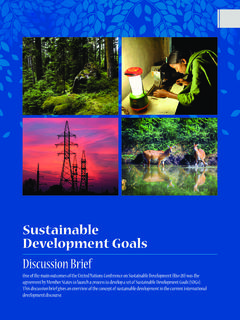Transcription of A briefing for Unite the union Regional Officers ...
1 HEALTHH ealth visiting in EnglandMay 2016 IntroductionThis briefing is written for Unite the union Regional Officers, representatives and members. It attempts to provide abackground and identify future risks and concerns related to health visitor members in visitors have been in the UK since 1862 when they started to work in Salford, Greater Manchester. The CommunityPractitioners & Health Visitors Association was formed in 1896 and has since then represented the majority of health visitors,and then later school nurses and community nursery nurses. 2016 marks the Association s 120th s a health visitor?Health visitors are registered nurses or midwives who are passionate about promoting healthy lifestyles and preventing work with families to give pre-school-age children the best possible start in visitors are required to complete additional education and gain a qualification in specialist community public healthnursing (at degree or masters level).
2 This additional training enables them to assess the health needs of individuals, families andthe wider community, with a view to early intervention. The role is primarily focused on working with children from birth to fiveyears old and their families. There are also specialist health visitors who focus on at-risk or deprived groups such as perinatalmental health, breastfeeding, domestic abuse or the homeless. Health visiting is based around four principles: Search for health needs Stimulation of an awareness of health needs Influence policies affecting health Facilitate health enhancing activitiesHealth Education England provides more information on their website, Health Careers to the health visitor implementation planUnite/CPHVA started to campaign in the 2000s when it realised that health visiting was facing a significant crisis. Although nopolicy of the last Labour government had suggested that the number of health visitors should be reduced, the number continuedto decline owing to local health highlighted the fact that between 2000 and 2011, the number of health visitors in England reduced by 21% (10,046 to7,941).
3 This was at a time when the number of under five year olds had increased by 12% ( million to million). Theeffect that this had on average caseload sizes was to increase them by 30% (297 to 419 children under-5 per health visitor). Each of the then 3 main political parties said something about health visiting in their election manifestos going in to the 2010general election. The Conservative Party appeared to be the most committed to affect change in this area. Indeed, they were thefirst to pick up our proposed figure of 4,200 more health visitors in a paper written by The Conservative Research Department Helping new families: Support in the early years through universal health visiting 2. In their 2010 general election partyA briefing for Unite the union Regional Officers,representatives and members they mentioned health visitors twice: We will support and improve Sure Start, and introduce a new universal healthvisiting service.
4 And Families need the best possible advice and support while their children are young. We will provide 4,200more Sure Start health visitors giving all parents a guaranteed level of support before and after birth until their child startsschool. This will be paid for out of the Department of Health budget and by refocusing Sure Start s peripatetic outreach services. This was then carried over to the coalition agreement4which pledged: We will refocus funding from Sure Start peripateticoutreach services, and from the Department of Health budget, to pay for 4,200 extra Sure Start health visitors. The Health visitor implementation plan : A call to action 5 was launched on the 8th February 2011 setting out the challengingcommitment to an extra 4,200 health visitors by 2015 .This identified that there would be an increase from the (original) May2010 baseline figure of 8,092 health visitors up to a final total of 12,348 by March on numbers of health visitorsBy March 2015 , the number of health visitors stood at 12,077; and although the target had been missed by 271, the increasein health visitor numbers from May 2010 to March 2015 was 49%.
5 Owing to this result, there is a risk that people may feel that health visitors had their investment at a time when other parts ofthe NHS and wider health sector faced considerable cuts between 2010-15. This would be true if it wasn t for two significantissues: The cuts that happened between 2000 and 2011 meant that the work force growth between 2000 and 2015 was only20%. This compared with a growth in all nursing, midwifery and health visiting professions (combined) of 22% The rapid increase in birth rate and therefore the number of under-5s in England which increased by 15% (2001-2014). of September 2015 there were 11,895 FTE health visitors in England. As the following chart shows, the HV plan was neverreached and the target is unlikely to be reached in the transfer of commissioning of health visiting services to local authoritiesOn the 1st October 2015 , the commissioning of health visiting was transferred to local authorities.
6 This followed the earliertransfer of school nurses in April 2013. One of the arguments for this transfer was that as the local authority were nowresponsible for public health, commissioning the 0-19 services would enable closer working and integration. There are however a range of risks that may come to light over the next months and years: The cuts to public health: At the point of transfer, the budgets for health visiting services were also transferred across to thelocal authority. However, at the same time, George Osborne has implemented large spending cuts to public health. Thisincluded 200 million cuts announced in-year in 2015 -16, a further 77 million cut in 2016-17 and 84 million cut in2017-186. The funding transferred with health visiting services was not ring fenced . Cuts to early intervention funding: At the beginning of March 2016, Action for Children, the National Children s Bureauand The Children s Society produced a report, Losing in the long run 7which highlighted that between 2000 and 2020, theamount spent by the government on early intervention would be cut by 71%.
7 The report included a helpful interactivemap8where you could look at the changes in funding from 2010 and the forecast for 2020. So for example, the 2010-11early intervention allocation (excluding 2-year-old offer) in Birmingham was million. By 2019-20 it is currentlypredicted to be allocated million; a cut of 72%. The local authority expertise in putting services out to tender: Local authorities have long experience of putting servicesout to tender. In health visiting, this isn t a new proposition as starting with Commissioning a patient led NHS9 (CaPLNHS),services were already being put out to tender with a range of providers winning these bids. The winning bidders rangedfrom local NHS services, third sector organisations, local authorities and private companies such as Virgin Care. It is to beexpected that the pace of these tenders will increase. This in itself is a concern but this will also be combined with thesenew tenders having less money identified to deliver these services; there are a number of case studies below.
8 In additionthere is a risk of fragmentation if different parts of the service are placed with different providers and of course the risk ofservices moving out of the NHS. Guidance versus instruction:There is very little instruction set out from the Department of Health. In terms of healthvisiting there are 5 visits/contacts which are mandated . This was set up as part of a sunset clause which runs from October2015 to March 2017. It is planned that it will be reviewed in October 2016 by Public Health England. Whether each areatakes mandation seriously is an important question and feedback from some parts of the country would suggest that theydon t, especially when it comes to carrying out antenatal contact. the terms of the Health and Social Care Act 201210 , upper-tier local authorities are now responsible for improving thehealth of their local population. Local authorities are key commissioners and hold an array of statutory duties for children,including: establishing arrangements to reduce child poverty promoting the interests of children in the development of health and wellbeing strategies (joining up commissioningplans for clinical and public health services with social care and education to address identified local health andwellbeing needs) leading partners and the public to ensure children are safeguarded and their welfare promoted driving the high educational achievement of all children leading, promoting and creating opportunities for co-operation with partners to improve the wellbeing of young core public health offer for all children includes.
9 Child health surveillance (including infant physical examination) and development reviews child health protection, immunisation and screening information, advice and support for children, young people and families early intervention and targeted support for families with additional needs health promotion and prevention by the multi-disciplinary team defined support in early years and education settings for children with additional and complex health needs additional or targeted public health nursing support as identified in the Joint Strategic Needs Assessment, for examplesupport for looked after children, young carers, or children of military families. The education of new health visitors: Under the implementation plan , universities had record numbers of student healthvisitors on their courses. In fact to try and meet the target some universities across England commenced two intakes peryear (normally health visiting courses start in the September, running to the following August).
10 We are already picking up onconcerns related to the courses for 2016-17. We have written to Health Education England11to highlight these concernswhich come under a number of categories: Universities are being told to hold back from recruiting their 2016/17 intake. Universities are being told that the local healthcare provider organisations can t afford to provide placements forstudents. Local LETBs (Health Education England Local Education and Training Boards) are reducing the number of theircommissioned places. Local healthcare provider organisations are making clear that they won t be able to recruit the students once Education England have responded to our letter12but the reply does not put our minds at rest. The government plan to remove bursaries for undergraduate health training and replace with a loan:It is not clear as yetwhat impact this decision may have on post registration education.
